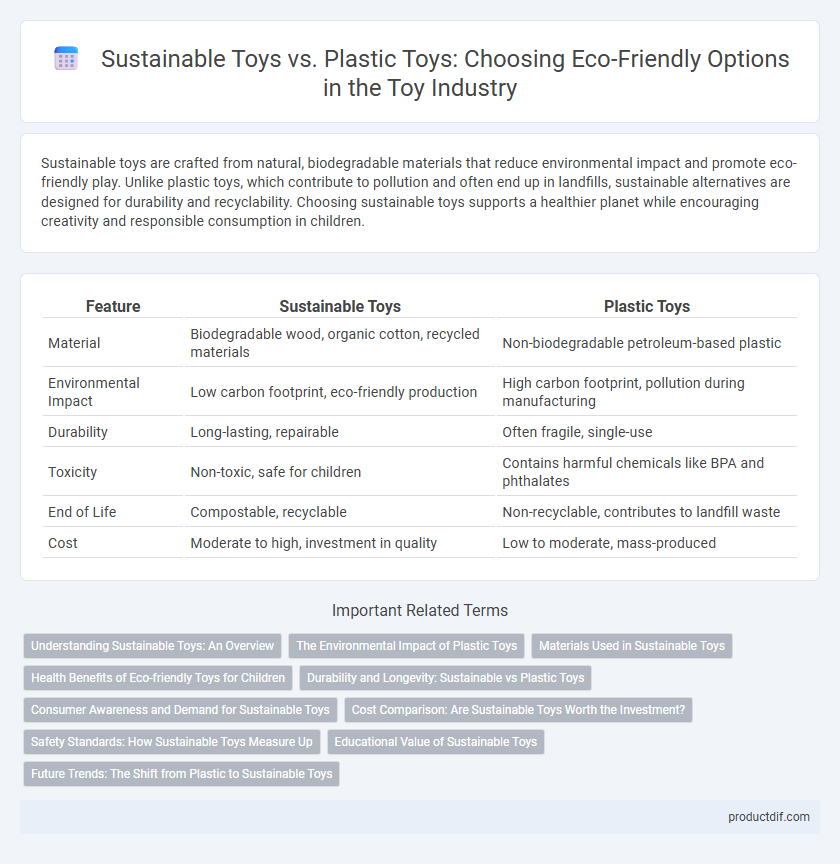Sustainable toys are crafted from natural, biodegradable materials that reduce environmental impact and promote eco-friendly play. Unlike plastic toys, which contribute to pollution and often end up in landfills, sustainable alternatives are designed for durability and recyclability. Choosing sustainable toys supports a healthier planet while encouraging creativity and responsible consumption in children.
Table of Comparison
| Feature | Sustainable Toys | Plastic Toys |
|---|---|---|
| Material | Biodegradable wood, organic cotton, recycled materials | Non-biodegradable petroleum-based plastic |
| Environmental Impact | Low carbon footprint, eco-friendly production | High carbon footprint, pollution during manufacturing |
| Durability | Long-lasting, repairable | Often fragile, single-use |
| Toxicity | Non-toxic, safe for children | Contains harmful chemicals like BPA and phthalates |
| End of Life | Compostable, recyclable | Non-recyclable, contributes to landfill waste |
| Cost | Moderate to high, investment in quality | Low to moderate, mass-produced |
Understanding Sustainable Toys: An Overview
Sustainable toys are crafted from eco-friendly materials such as organic cotton, bamboo, and recycled wood, minimizing environmental impact compared to traditional plastic toys made from non-biodegradable polymers. They emphasize durability, safety, and ethical production practices, reducing waste and promoting long-term use. Choosing sustainable toys supports environmental conservation and fosters awareness of responsible consumption in children.
The Environmental Impact of Plastic Toys
Plastic toys contribute significantly to environmental pollution due to their non-biodegradable nature and reliance on fossil fuels for production, leading to increased carbon emissions. These toys often end up in landfills or oceans, causing long-term ecological damage and harming marine life through microplastic contamination. Sustainable toys, made from renewable materials like wood or recycled plastics, reduce waste and carbon footprint, promoting a healthier ecosystem.
Materials Used in Sustainable Toys
Sustainable toys primarily use eco-friendly materials such as organic cotton, natural wood, bamboo, and non-toxic dyes, ensuring minimal environmental impact. These materials are biodegradable, renewable, and often sourced from responsibly managed forests or recycled content, reducing waste and pollution. In contrast, plastic toys typically rely on petroleum-based polymers that contribute to long-lasting environmental pollution and are less sustainable in production and disposal.
Health Benefits of Eco-friendly Toys for Children
Eco-friendly toys made from natural materials like wood, organic cotton, and biodegradable components offer significant health benefits by reducing exposure to harmful chemicals such as phthalates, BPA, and PVC commonly found in plastic toys. These sustainable toys support better respiratory health and lower the risk of allergies and skin irritations in children, promoting safer playtime environments. Choosing eco-friendly alternatives helps parents prioritize their children's well-being while fostering environmental responsibility from an early age.
Durability and Longevity: Sustainable vs Plastic Toys
Sustainable toys are crafted from eco-friendly materials such as wood, bamboo, or recycled fabrics, enhancing their durability and lifespan compared to conventional plastic toys. High-quality sustainable toys often resist wear and tear, reducing the need for frequent replacements and minimizing environmental impact. Plastic toys, while initially inexpensive, tend to degrade or break faster, leading to increased waste and shorter product lifecycles.
Consumer Awareness and Demand for Sustainable Toys
Rising consumer awareness about environmental impact drives increased demand for sustainable toys made from biodegradable or recycled materials. Studies show parents prioritize non-toxic, eco-friendly products to ensure child safety and reduce plastic waste. Market trends indicate a steady growth in sustainable toy sales, reflecting shifting preferences towards greener alternatives over conventional plastic toys.
Cost Comparison: Are Sustainable Toys Worth the Investment?
Sustainable toys, typically made from eco-friendly materials like bamboo, wood, or recycled plastics, often come with a higher upfront cost compared to conventional plastic toys, which are mass-produced and cheaper due to lower material and manufacturing expenses. Despite the initial investment, sustainable toys offer long-term value through durability, non-toxicity, and reduced environmental impact, potentially saving money on replacements and healthcare costs related to harmful chemicals found in some plastic toys. When factoring in environmental benefits and improved safety, many consumers find the higher price of sustainable toys justifiable as a cost-effective choice for both families and the planet.
Safety Standards: How Sustainable Toys Measure Up
Sustainable toys often meet or exceed safety standards by using non-toxic, biodegradable materials that reduce exposure to harmful chemicals commonly found in plastic toys. These toys undergo rigorous testing to ensure durability and child safety, adhering to certifications like ASTM F963 and EN71. In contrast, plastic toys may contain BPA, phthalates, and other hazardous substances that pose health risks, making sustainable alternatives a safer choice for children.
Educational Value of Sustainable Toys
Sustainable toys are crafted from eco-friendly materials such as wood, organic cotton, and recycled fibers, offering rich educational value by promoting environmental awareness and sensory development. Unlike plastic toys, which often prioritize mass production and short-term entertainment, sustainable toys encourage creativity, problem-solving skills, and hands-on learning through natural textures and open-ended play. Investing in sustainable toys supports cognitive growth and instills lifelong values of sustainability and responsible consumerism in children.
Future Trends: The Shift from Plastic to Sustainable Toys
Future trends in the toy industry emphasize a significant shift from plastic toys to sustainable alternatives crafted from biodegradable materials like bamboo, organic cotton, and recycled wood. Growing consumer awareness and stricter environmental regulations drive manufacturers to innovate eco-friendly designs that reduce carbon footprints and promote circular economy principles. Advancements in sustainable production technologies and the rise of ethically sourced components are set to dominate the market, shaping a greener future for children's playthings.
Sustainable toys vs plastic toys Infographic

 productdif.com
productdif.com